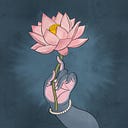Narasiṃha in the Poetry of the Āḻvārs
As the Bhāgavata movement along with the cult of Narasimha grew popular in the Tamil land, the devotional literature of the Āḻvārs turned replete with references to the various avatars of Viṣṇu, including Narasiṃha, who was mentioned in eight of the Āḻvārs’ works.
The first is Poygai Alvar, who was from Kañci, referred to Narasiṃha in his “Mutal Tiru Vandādi”, as “iranīya naippun niraṅdavallu kirār” — “one who is capable of making the ulcer full of Hiraṇyakaśipu”. Pūtattaār and Pēy Āḻvār praised Narasiṃha as ‘Siṅgamāye’, being made himself of the bodyog the lion. Tirumaḻiṣai Āḻvār, a disciple of Pēy Āḻvār wrote “Nanmukhan Tiruvaṅdāḍi”, in which Narasiṃha is “Ariyuru Vomāi” or “one who bore the body of a lion”. Viṣṇu is praised as “one who destroyed Hiraṇyakaśipu in a day, and the being who created Gods, men, animals and plants.”
Nammāḻvār, who is viewed as the Kulapati of the Śri Vaiṣṇava theology, composed multiple pāsurās in honour of ‘Narasiṅga’ in his Tiruvāymoḻi. The name, Narasiṅka, a variation of Narasiṁha, is used for the first time in Tiruvāymoḻi in the context of several references to the killing of Hiraṇyakaśipu (gold-clothed one), the older brother of Hiraṇyākṣa (gold-eyed one) who was killed by Viṣṇu as his earlier incarnation, Varāha.
“I think only of you. I sing great words.
I dance. I pull out my evil deeds, roots and all.
You ripped the broad chest of Hiraṇyaṉ
who slighted you in his thoughts,
my primordial lion
what can’t I do now?”
Tiruvāymoḻi II.6.6
“Dusk set. The sky turned red
a river of blood flooded the sky, when he came
a lion tearing through a mountain
this is how my father
killed the demon who brought such sorrow.”
Tiruvāymoḻi VII.4.6
In this verse the mountain in question is the body of the demon Hiraṇyakaśipu, and the sky turns red from the blood that gushes out of his chest when Narasiṁha disembowels the demon. Narasiṁha kills the demon at dusk, so the red of the setting sun echoes this moment. A similar verse (IV.8.7) follows:
“A flawless lion burst out
fiery with rage and bright as light,
tore open Hiraṇyaṉ’s massive chest
and roared with joy.
He holds a disc of fire and the right-turning conch
my pretty bangles are useless
if they can’t enchant him
dark and brilliant as a gem.”
Tiruvāymoḻi IV.8.7
The following verse, also from Nammāḻvār further alludes to Hiraṇyakaśipu’s challenge to Prahlāda, who, knowing the supremacy of Viṣṇu, speaks of his omniscience and omnipotence.
“‘Kaṇṇaṉ is everywhere’ claimed the boy
‘He’s not here’ replied Hiraṇyaṉ
and struck the pillar.
There, right then, to his astonishment
he appeared, my lion.
Who can know his greatness?”
Tiruvāymoḻi II.8.9
“When Hiraṇyaṉ with power earned
off limitless austerity tormented the gods,
he came as an enormous lion and
mauled his demon-body.
Knowing his mysterious ways,
can you learn of anyone else?”
Tiruvāymoḻi VII.5.8
“He came as a lion, took pleasure
in mauling the demon,
he’s the dear one with the disc
Those who master these ten from the thousand
by Śaṭhakōpaṉ of Kurukūr
will be praised and served by beautiful women.”
Tiruvāymoḻi VII.6.11
Next, Periyāḻvār, who hailed from Śrivlliputtūr referenced in his Tirumoḻi of Narasiṃha as “Narasasiṅganai” and praised thr rescue of his devotee Prahlāda from the clutches of the demon Hiraṇyakaśipu. Periyāḻvār also praised those who worshipped Narasiṃha and sang his glory.
Tiruappan āḻvār spoke of Narasiṃha as “parianāgi vaṅda vavuṅa nudal keeṇṇa”, or one who has killed his enemy, Hiraṇyakaśipu. In his book Amalanādippiran, he writes, “The dark broad eyes, shining with red lines and with long eyelashes, have entranced me truly. Oh lord! Thou tore the body of the great asura (Hiraṇyakaśipu) being immortal and the primal cause of all.”
Tirumangai āḻvār, who was a king of Travancore, called Narasiṃha as “singa vēlkuṇṇamē”, or one who bears the form of a lion” in his “Peria-tirumadal”. He also wrote ten verses attesting to the greatness of Narasiṃha and the Ahōbila kṣetra.
References
- History of the Cult of Narasimha in Telangana (Andhra Pradesh — from Ancient to the Modern Period — Dr. Madabhushini Narasimhacharya [1st edition, 1989]
2. Endless Song: Tiruvāymoḻi; Nammalvar; translated by Archana Venkatesan
__________________________________________
If you find value in my work, I hope you consider becoming a patron or making a contribution to hindu.aesthetic@okicici. Hindu Aesthetic requires a lot of time and effort and your support would mean that I can continue bringing you the best possible content. ❤
